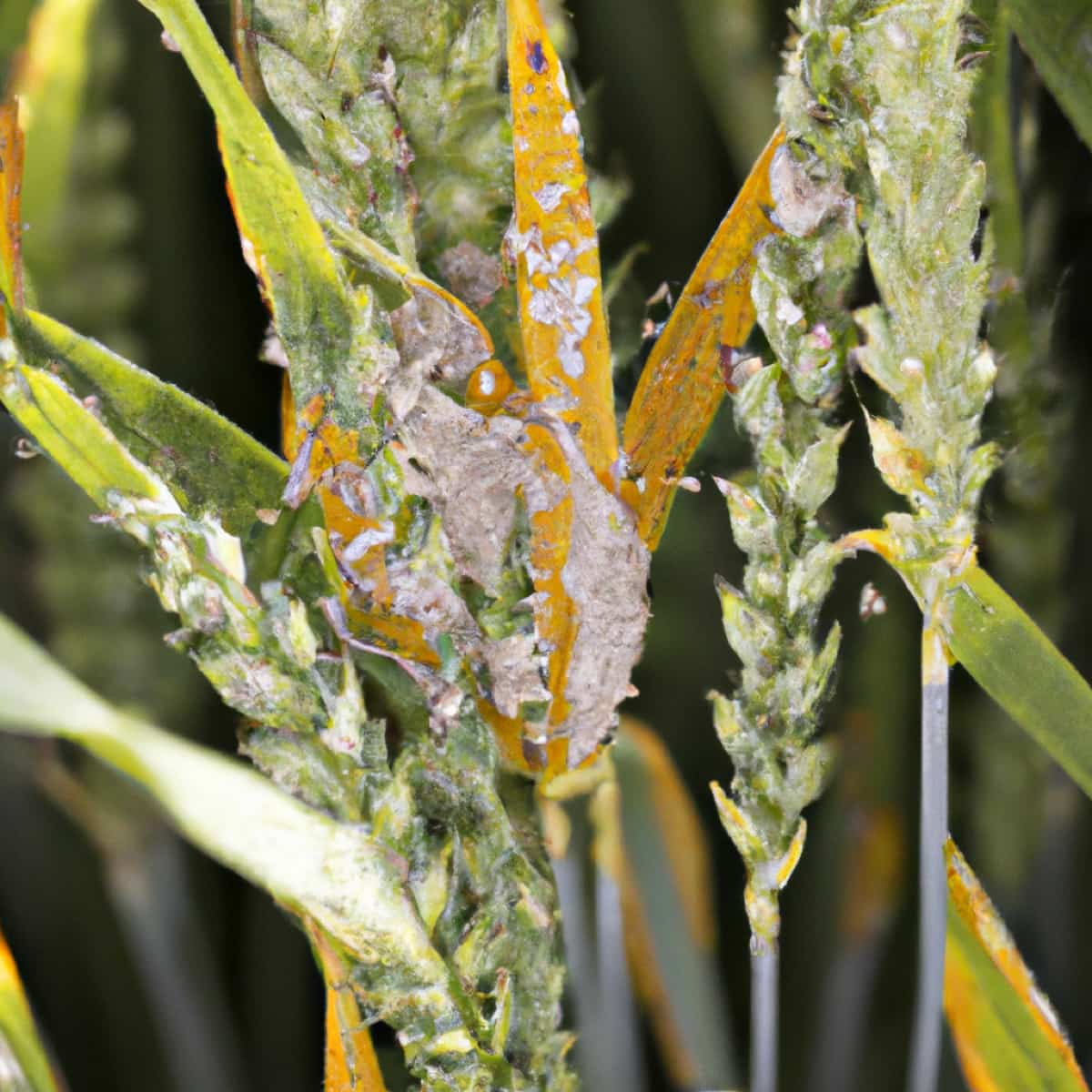Loose Smut is a fungal disease that primarily damages wheat fields in India. It is a disease of wheat crops caused by the fungus Ustilago nuda tritici. The fungus infects the wheat plant during its early growth stages. It produces smut fragments that replace the developing kernels, leading to reduced yields and lower-quality grain.

It is especially harmful in Punjab, Uttar Pradesh, and certain parts of Madhya Pradesh. According to Luthra, in 1953, the Disease caused enormous financial losses, with an estimated loss of more than 50 million rupees per year in India. Kangiari is the native name for sickness in Punjab. It generates smut spores that replace growing kernels, resulting in decreased yields and worse grain quality.
Loose Smut disease management in Wheat
The causal organism of Loose Smut disease
- The causal organism of Loose Smut disease is a fungus, Ustilago nuda tritici, with hyaline mycelium that turns brown near maturity.
- The mycelium is septate, dikaryotic, and grows systemically inside the plant.
- At maturity, mycelial cells transform into brown, spherical, echinulate teleutospores that serve as infective agents.
- The teleutospores germinate, producing pro-mycelium or basidium consisting of four uninucleate cells.
- Unlike other smut-causing fungi, the basidium does not produce basidiospores but instead germinates to produce uninucleate hyphae.
- A pair of sexually compatible uninucleate primary hyphae fuse to form a dikaryotic hypha, also known as the “infection hypha,” which causes infection in the plant.
Disease cycle of Loose Smut disease
Perennation
The pathogen survives in the form of dormant mycelium within the infected kernel. This mode of survival is unique to loose Smut, as other smut diseases of wheat plants survive as fragments on the surface of the seed.
In case you missed it: Brown Rust Disease Management in Wheat: Symptoms, Treatment, Chemical, Biological, Natural, and Organic Control

Primary infection
The dormant mycelium becomes active during seed germination and growth of the seedling, spreading systemically through the plant. The mycelium turns brown when mature and accumulates in the floral parts. Teleutospores form and are spread by the wind into adjacent flowering plants.
The teleutospores germinate and produce sexually compatible primary hyphae that fuse and give rise to dikaryotic mycelium (infection hyphae). The infection hyphae penetrate the flower and become established in the embryo’s tissues before the kernels mature. The mycelium becomes dormant within the scutellum of the kernel.
Secondary infection
Although the teleutospores can germinate on flowers of healthy plants, the mycelium becomes inactive and remains dormant within the seed, leading to no secondary infection cycle during the same growing season.
Favorable conditions for the spread of Loose Smut disease
- Moisture: 60-85% relative humidity is ideal for serious infection of healthy flowering and plants.
- Temperature: The temperature during flowering (18-20°C) and seedling growth to spike emergence (19°C) is critical for disease development. The higher the temperature, the lower the disease incidence.
- Seedling growth and spike emergence: The temperature during this stage determines the severity of the Disease. A temperature of 19°C results in heavy disease incidence, a temperature of 24°C results in moderate incidence, and 29°C results in no disease.
Symptoms of Loose Smut disease in Wheat
- Diseased plants in wheat crops infected with Loose Smut may not be noticeable until they head earlier than healthy plants.
- The Disease’s main symptom is the production of black powder in place of wheat grains in the ears, with almost every ear of the diseased plant being affected.
- The black powder is a mass of olive-green microscopic fragments of the smut fungus that can infect healthy plants when blown to their flowers.
- The fungus infects the developing seed and remains dormant in the mature grain until germination.
- As the germination starts, the fungus inside the infected seed becomes active and grows.
- The fungus first grows inside the plant behind the growing point, keeping pace with the apex of the growing shoot.
- As ear formation starts, the fungus accumulates in the floral parts, resulting in the complete destruction of the floral parts and the formation of the black powder.
Percentage of yield loss due to Loose Smut disease in Wheat crop
- The Loose Smut disease results in significant yield loss in infected wheat crops. The yield reduction can range anywhere from 20 to 50 percent, depending on the severity of the Disease.
- While the yield is greatly impacted, the quality of the grain is not affected as the fungus does not impact the formation of the kernels.
In case you missed it: Common Rust Disease Management in Maize: Symptoms, Treatment, Chemical, Biological, Natural, and Organic Control

Loose Smut disease management in Wheat by cultural methods
- Rogueing: Uprooting and burning infected ears as soon as they emerge.
- Use of resistant varieties
- Bury the infected ear heads in the dirt to prevent subsequent spread.
- Threshing seeds for sowing from uninfected wheat ears.
- The diseased plants should be carefully pulled and packed in polythene bags before being buried in the soil or burned.
- Only healthy, certified seeds should be planted.
Loose Smut disease management in Wheat by chemical methods
- Loose Smut disease is controlled through seed treatment with a systemic fungicide that penetrates the seedling to eliminate the internal infection.
- Before planting, apply Vitavax at a rate of 2g/kg seed.
- Fungicides are effective in controlling the seed-borne loose smut disease of Wheat. D735 (Vitavax) and F461 (Plantavax) at 2.5 g per kg and Benomyl and Carboxin at 0.25%, when applied as seed dressing fungicides, have given positive results.
- Thiabendazole at 0.1 to 0.2% as a seed treatment is highly effective in controlling the disease without impacting germination,
Loose Smut disease management in Wheat by natural/organic methods
- Soak the infected seed in water for 4 hours
- Dry seed under the hot sun in the afternoon
- Store well-dried seed for next season
- Solar heat treatment kills the dormant fungus in the seed.
- Hot Water Treatment is a method to control the loose smut disease of Wheat. The grains are soaked in water between 26°C-30°C for 4-5 hours to activate the dormant mycelium.
- Then the water temperature is raised to 54°C for 10 minutes to kill the activated mycelium.
Conclusion
Rogueing, seed treatment with fungicides, hot water treatment, and solar heat therapy are all used to combat loose smut disease in Wheat. Fungicides like Benomyl, Carboxin, and Thiabendazole have been proven effective as seed dressing. Proper seed selection, storage, and handling can also aid in the prevention of disease transmission.
- Deworming Schedule for Dogs/Puppies: A Beginners Guide
- How to Prevent and Control Parasites in Goats
- Beneficial Insects in Pest Management
- Natural Solutions for Pest Control in Flower Gardens
- Types of Fungicides Used in Agriculture
- Common Issues in the Fruit Development Stage of Pomegranate Farming
- Fruit Development Issues in Papaya: Easy Solutions and Treatment
- Soil-Borne Diseases and How to Protect Your Plants
- Practices to Prevent Disease Spread in the Garden